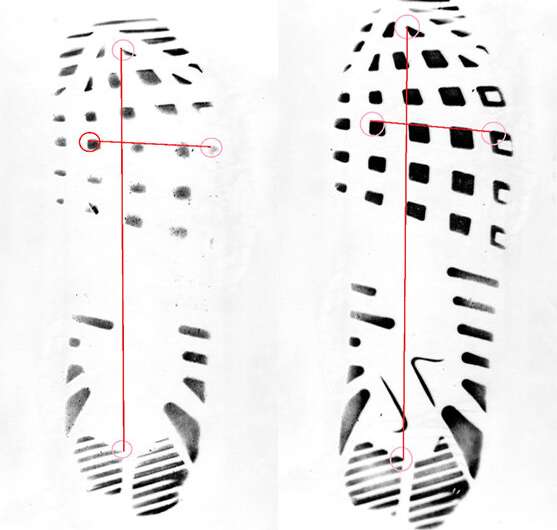This article has been reviewed according to Science X's editorial process and policies. Editors have highlighted the following attributes while ensuring the content's credibility:
fact-checked
trusted source
proofread
Project helps to improve forensic shoeprint scanning accuracy

Research involving the University of Huddersfield is helping to improve accuracy in the field of forensic comparison.
The University's Dr. Sarah Reel led on an assessment of a system called TreadMatch for Yorkshire and the Humber Regional Scientific Support Services (YatH RSSS), based in nearby Wakefield. Currently TreadMatch takes digital scans from the footwear of persons detained in custody. The National Footwear Database (NFD) auto codes the scans and provides intelligence relating to crimes in the area where similar footwear patterns have been recovered.
However, footwear experts at YatH RSSS saw potential for this system to be further exploited, with the digital scans being used for preliminary comparison against crime scene marks.
Dr. Reel, along with a Master's student from Huddersfield, carried out a series of repeatability tests on data collected by footwear experts at YatH RSSS. They assessed how accurately TreadMatch was replicating the size of the digital TreadMatch scans, with the results now collated in a paper published in Science & Justice.
"Footwear had been placed on the TreadMatch scanner in a variety of ways by footwear experts at RSSS, both with someone's foot in the shoe or by rolling the shoe by hand to take a print," says Dr. Reel.
"The usual way of taking a print from a suspect's shoe for comparison with a crime scene footwear mark involves seizing the detainee's shoes and submitting them to the laboratory for comparison. This process can delay a comparison while a person is in custody. If the digital scans taken on TreadMatch accurately depict the shoe's tread, they could be used in real-time preliminary comparisons against the crime scene mark, potentially saving Police Officer time and resources.
Dr. Reel's repeatability tests used a large sample of different sizes and makes of shoes, to figure out whether the TreadMatch scanner was replicating the size, width and length of the outsole shoe pattern.
"The results showed they were repeatable," she adds. "It did not matter what size the shoe was, it came out as reliable, but we did find that the hand-rolled method was not as accurate as the walk-on one. It was not picking up the print very well, and it's important to get all the characteristics of the outsole pattern right to the edge of a shoe."
The next stage of the research will be to investigate the accuracy of the comparison of digital TreadMatch scans with the crime scene marks, compared with the manual method currently used.
Ryan Harris, Footwear Expert at YatH RSSS said, "TreadMatch has the potential to save time and resources by facilitating forensic comparisons that would otherwise not have taken place due to time constraints. This will be particularly beneficial to police forces who use a regional scientific service, where the custody suites are significant distances from the forensic provider."
More information: Sarah Reel et al, The application of TreadMatch scans to aid the process of footwear mark comparison, Science & Justice (2022). DOI: 10.1016/j.scijus.2022.07.011
Provided by University of Huddersfield





















